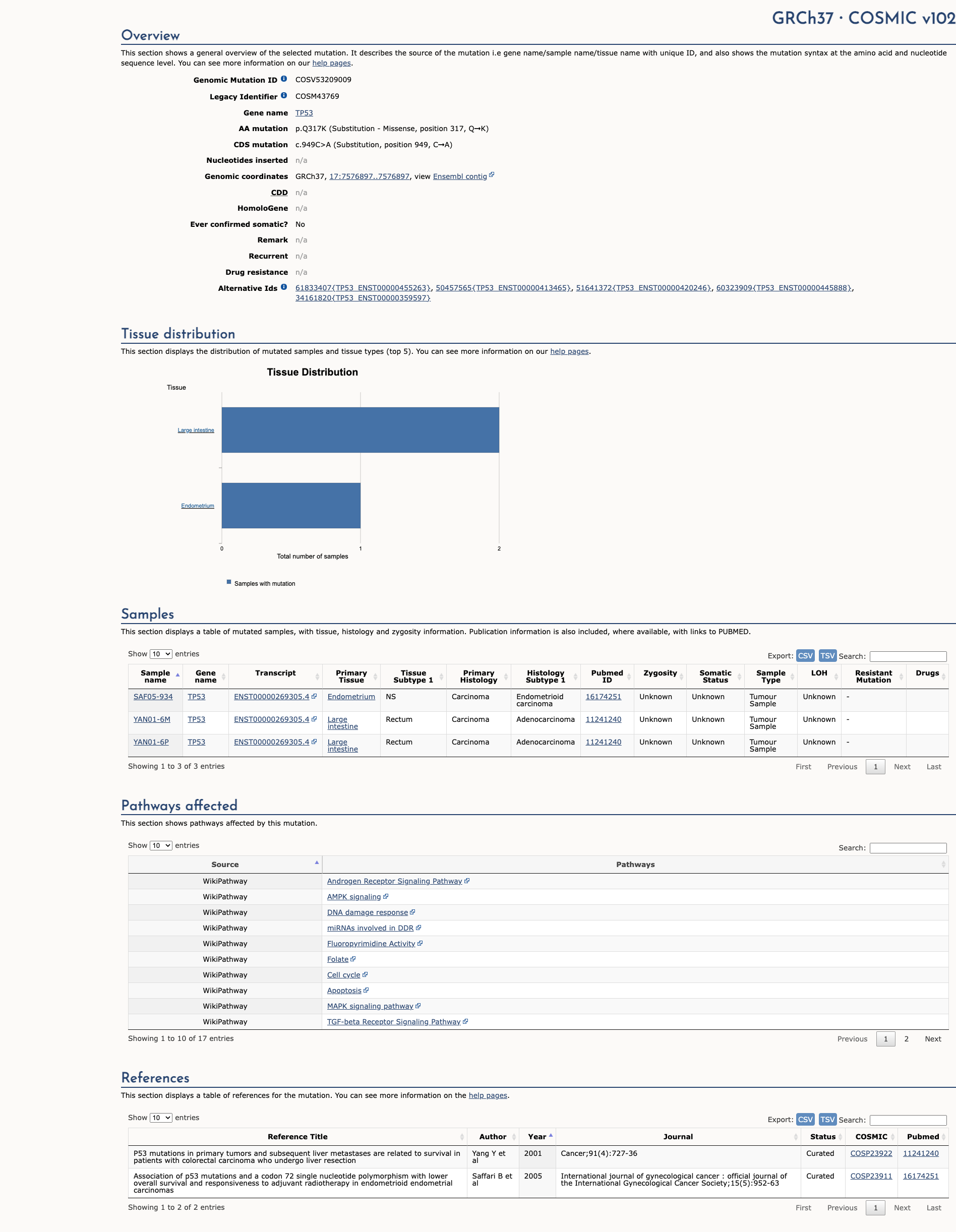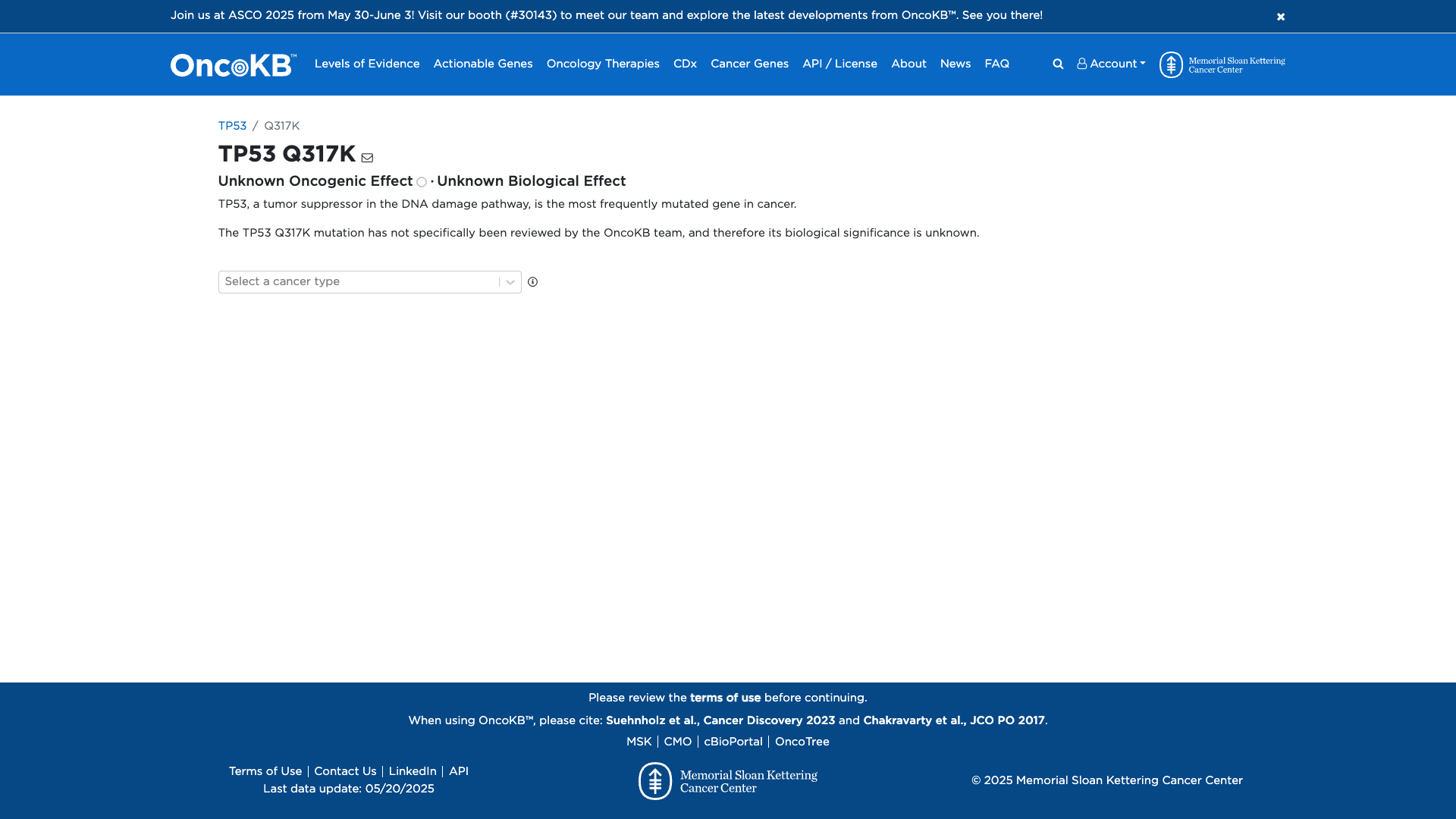TP53 c.949C>A, p.Gln317Lys
NM_000546.6:c.949C>A
COSMIC ID: COSM43769
Variant of Uncertain Significance (VUS)
TP53 p.Q317K is a rare missense variant (PM2_Supporting) with benign computational predictions (BP4_Supporting), lacking functional, segregation, or case data to support either pathogenicity or benign impact. The variant remains classified as VUS.
ACMG/AMP Criteria Applied
PM2
BP4
Genetic Information
Gene & Transcript Details
Gene
TP53
Transcript
NM_000546.6
MANE Select
Total Exons
11
Strand
Reverse (−)
Reference Sequence
NC_000017.10
Alternative Transcripts
| ID | Status | Details |
|---|---|---|
| NM_000546.5 | RefSeq Select | 11 exons | Reverse |
| NM_000546.3 | Alternative | 11 exons | Reverse |
| NM_000546.4 | Alternative | 11 exons | Reverse |
| NM_000546.2 | Alternative | 11 exons | Reverse |
Variant Details
HGVS Notation
NM_000546.6:c.949C>A
Protein Change
Q317K
Location
Exon 9
(Exon 9 of 11)
5'Exon Structure (11 total)3'
Functional Consequence
Loss of Function
Related Variants
No evidence of other pathogenic variants at position 317 in gene TP53
Alternate Identifiers
COSM43769
Variant interpretation based on transcript NM_000546.6
Genome Browser
Loading genome browser...
HGVS InputNM_000546:c.949C>A
Active Tracks
ConservationRefSeqClinVargnomAD
Navigation tips: Use mouse to drag and zoom. Click on features for details.
Clinical Data
Global Frequency
0.000707%
Very Rare
Highest in Population
European (non-Finnish)
0.00155%
Rare
Global: 0.000707%
European (non-Finnish): 0.00155%
0%
0.05%
0.1%
1%
5%
10%+
Allele Information
Total: 282868Alt: 2Homozygotes: 0
ACMG Criteria Applied
PM2
This variant is present in gnomAD (MAF= 0.000707%, 2/282868 alleles, homozygotes = 0) and at a higher frequency in the European (non-Finnish) population (MAF= 0.00155%, 2/129172 alleles, homozygotes = 0). The variant is rare (MAF < 0.1%), supporting PM2 criterion application.
Classification
6 publications
Uncertain Significance (VUS)
Based on 8 submitter reviews in ClinVar
Submitter Breakdown
3 VUS
5 LB
Pathogenic
Likely Path.
VUS
Likely Benign
Benign
Publications (6)
In the published literature, this variant has been reported in individuals affected with ovarian cancer (PMID: 30441849 (2018)) and chronic lymphocytic leukemia (PMID: 25527155 (2015)). Functional studies indicate that this variant retains binding and transcriptional activity (PMID: 12826609 (2003), 30224644 (2018)). The frequency of this variant in the general population, 0.0000071 (2/282868 chromosomes (Genome Aggregation Database, http://gnomad.broadinstitute.org)), is uninformative in the assessment of its pathogenicity. Based on the available information, we are unable to determine the clinical significance of this variant.
This alteration is classified as likely benign based on a combination of the following: seen in unaffected individuals, population frequency, intact protein function, lack of segregation with disease, co-occurrence, RNA analysis, in silico models, amino acid conservation, lack of disease association in case-control studies, and/or the mechanism of disease or impacted region is inconsistent with a known cause of pathogenicity.
This missense variant replaces glutamine with lysine at codon 317 of the TP53 protein. Computational prediction suggests that this variant may not impact protein structure and function (internally defined REVEL score threshold <= 0.5, PMID: 27666373). Functional studies have shown that the mutant protein retains normal function (PMID 12826609, 25527155, 30224644). This variant has been reported in an individual affected with chronic lymphocytic leukemia (PMID 25527155). In a large international case-control study, this variant was reported in 5/60466 breast cancer cases and 4/53461 controls (PMID: 33471991). This variant has been identified in 2/282868 chromosomes in the general population by the Genome Aggregation Database (gnomAD). The available evidence is insufficient to determine the role of this variant in disease conclusively. Therefore, this variant is classified as a Variant of Uncertain Significance.
Clinical Statement
This variant has been reported in ClinVar as Uncertain significance (3 clinical laboratories) and as Likely benign (5 clinical laboratories) and as Uncertain Significance (1 clinical laboratories) and as Benign by ClinGen TP53 Variant Curation Expert Panel, ClinGen expert panel.
Expert Panel Reviews
Benign
ClinGen TP53 Variant Curation Expert Panel, ClinGen
Functional Impact
Functional Domain
Hotspot Status
Hotspot
PM1
Mutation Count
32
Reported mutations in this domain
050100+
Domain Summary
This variant is located in a mutational hotspot or critical domain (32 mutations).
PM1 criterion applied.
Related Variants in This Domain
No evidence of other pathogenic variants at position 317 in gene TP53
Computational Analysis
Pathogenicity Predictions
REVEL Score
0.321
0.321
Likely Benign0.0
Uncertain (Low)0.2
Uncertain (Med)0.5
Likely Pathogenic0.75
REVEL scores ≥ 0.75 are strong evidence (PP3)
Predictor Consensus
Mixed/VUS
PP3 Applied
No
Additional Predictors
Pathogenic:
metasvm: Dmetalr: D
Benign:
CADD: 1.44polyphen_prediction: benignprimateai: T
Neutral: Show all
VCEP Guidelines
Applied ACMG/AMP Criteria (VCEP Specific) VCEP Guidelines
PVS1
PVS1 (Not Applied) Strength Modified
According to VCEP guidelines, 'PVS1 applies to predicted null variants in TP53'. The evidence for this variant shows it is a missense change (c.949C>A, p.Q317K) not predicted to result in loss-of-function. Therefore, PVS1 is not applied.
PS1
PS1 (Not Applied) Strength Modified
According to VCEP guidelines, 'PS1 Strong: same amino acid change as a previously established pathogenic variant'. No previously established pathogenic variant results in p.Q317K. Therefore, PS1 is not applied.
PS2
PS2 (Not Applied) Strength Modified
According to VCEP guidelines, 'PS2 Very Strong: de novo (both maternity and paternity confirmed)'. There are no reported de novo occurrences for this variant. Therefore, PS2 is not applied.
PS3
PS3 (Not Applied) Strength Modified
According to standard ACMG guidelines, 'PS3: well-established functional studies supportive of a damaging effect on the gene or gene product'. No functional studies have been performed for TP53 p.Q317K. Therefore, PS3 is not applied.
PS4
PS4 (Not Applied) Strength Modified
According to VCEP guidelines, 'PS4: increased prevalence in affected individuals based on proband counts or case-control data'. No case or proband data available for this variant. Therefore, PS4 is not applied.
PM1
PM1 (Not Applied) Strength Modified
According to VCEP guidelines, 'PM1 Moderate: missense variants within hotspot codons 175, 245, 248, 249, 273, 282'. p.Q317K is at codon 317, outside of these hotspots, with zero somatic occurrences. Therefore, PM1 is not applied.
PM2
PM2 (Supporting) Strength Modified
According to VCEP guidelines, 'PM2 Supporting: allele frequency <0.00003 in gnomAD'. The variant frequency is 2/282,868 (0.00000707), below the threshold. Therefore, PM2 is applied at Supporting strength.
PM3
PM3 (Not Applied) Strength Modified
According to standard ACMG guidelines, 'PM3: detected in trans with a pathogenic variant for recessive disorders'. TP53 is associated with autosomal dominant disease and no trans observations exist. Therefore, PM3 is not applied.
PM4
PM4 (Not Applied) Strength Modified
According to standard ACMG guidelines, 'PM4: protein length changes due to in-frame deletions/insertions'. This variant is a missense change without alteration of protein length. Therefore, PM4 is not applied.
PM5
PM5 (Not Applied) Strength Modified
According to VCEP guidelines, 'PM5: different missense variant at the same residue previously classified as pathogenic'. No other pathogenic variant at codon 317 has been reported. Therefore, PM5 is not applied.
PM6
PM6 (Not Applied) Strength Modified
According to VCEP guidelines, 'PM6: assumed de novo without confirmation of paternity and maternity'. No de novo data exist. Therefore, PM6 is not applied.
PP1
PP1 (Not Applied) Strength Modified
According to VCEP guidelines, 'PP1: cosegregation in affected family members'. No segregation data are available. Therefore, PP1 is not applied.
PP2
PP2 (Not Applied) Strength Modified
According to standard ACMG guidelines, 'PP2: missense variant in a gene with a low rate of benign missense variation'. TP53 tolerates both benign and pathogenic missense changes, so PP2 is not applied.
PP3
PP3 (Not Applied) Strength Modified
According to VCEP guidelines, 'PP3 Moderate: missense variants with BayesDel ≥0.16 and aGVGD C65'. In silico predictions for p.Q317K are mixed, BayesDel is unknown, and SpliceAI is low. Therefore, PP3 is not applied.
PP4
PP4 (Not Applied) Strength Modified
According to standard ACMG guidelines, 'PP4: patient's phenotype or family history highly specific for a disease with a single genetic etiology'. No clinical phenotype was provided. Therefore, PP4 is not applied.
PP5
PP5 (Not Applied) Strength Modified
According to standard ACMG guidelines, 'PP5: reputable source classifies as pathogenic without available evidence'. No such classification for p.Q317K exists. Therefore, PP5 is not applied.
BA1
BA1 (Not Applied) Strength Modified
According to VCEP guidelines, 'BA1 Stand Alone: filtering allele frequency ≥0.001 in gnomAD'. The allele frequency is 0.00000707, well below the threshold. Therefore, BA1 is not applied.
BS1
BS1 (Not Applied) Strength Modified
According to VCEP guidelines, 'BS1 Strong: filtering allele frequency ≥0.0003 but <0.001'. The allele frequency is 0.00000707, below the threshold. Therefore, BS1 is not applied.
BS2
BS2 (Not Applied) Strength Modified
According to VCEP guidelines, 'BS2 Strong: ≥8 unrelated females ≥60 years without cancer'. No such observations exist. Therefore, BS2 is not applied.
BS3
BS3 (Not Applied) Strength Modified
According to VCEP guidelines, 'BS3: well-established functional studies show no loss of function'. No functional assays for p.Q317K are available. Therefore, BS3 is not applied.
BS4
BS4 (Not Applied) Strength Modified
According to VCEP guidelines, 'BS4 Strong: lack of segregation in affected family members'. No segregation studies exist. Therefore, BS4 is not applied.
BP1
BP1 (Not Applied) Strength Modified
According to standard ACMG guidelines, 'BP1: missense variant in a gene where only truncating variants cause disease'. TP53 has known pathogenic missense variants. Therefore, BP1 is not applied.
BP2
BP2 (Not Applied) Strength Modified
According to standard ACMG guidelines, 'BP2: observed in cis/trans with a pathogenic variant'. No such observations are reported. Therefore, BP2 is not applied.
BP3
BP3 (Not Applied) Strength Modified
According to standard ACMG guidelines, 'BP3: in-frame indels in repetitive regions without a known function'. This is a missense change, not an indel. Therefore, BP3 is not applied.
BP4
BP4 (Supporting)
According to VCEP guidelines, 'BP4 Supporting: BayesDel <0.16 and >-0.008 and no predicted splicing impact (SpliceAI <0.2)'. SpliceAI = 0.03 and in silico predictors overall suggest benign impact. Therefore, BP4 is applied at Supporting strength.
BP5
BP5 (Not Applied) Strength Modified
According to standard ACMG guidelines, 'BP5: variant found in a case with an alternate molecular basis for disease'. No such case data exist. Therefore, BP5 is not applied.
BP6
BP6 (Not Applied) Strength Modified
According to standard ACMG guidelines, 'BP6: non-expert source classifies as benign without available evidence'. No non-expert benign assertions were used. Therefore, BP6 is not applied.
BP7
BP7 (Not Applied) Strength Modified
According to VCEP guidelines, 'BP7: synonymous or intronic variant outside core splice sites with no predicted splicing impact'. This variant is missense. Therefore, BP7 is not applied.



